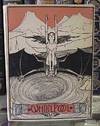
Martha Maxwell's Menagerie.
by Thompson, Lex
- Used
- Hardcover
- Signed
- Condition
- See description
- Seller
-
Hoover, Alabama, United States
Payment Methods Accepted
About This Item
Minneapolis, Minnesota:: Lex Thompson,, 2017/2019.. Edition of 5. Two volumes in wooden slipcase with dovetailed design along edges and laser etched illustration on sides with an M on the spine. Texts cited from Mary Emma Thompson's 'On the Plains, and Among the Peaks, or, How Mrs. Maxwell Made Her Natural History Collection' (Philadelphia: Claxton, Remsen & Haffelfinger, 1879).
Volume 1 "A Catalog of Martha Maxwell's Menagerie of Mammal and Bird Specimens (as far as is possible) as taken account of" by Elliott Coues & Robert Ridgeway": 8.5 x 6 x 2"; 310 pages. Case bound in lime green book cloth, smyth sewn. Gold gilt edge with gilt line illustration and titles on front board. Hand marbled endsheet. Printed and bound by Conveyor Editions. Illustrated plates (hunted and cut from field guides) by Lex Thompson. Signed and numbered by Thompson.
Volume 2 "A Catalog of Martha Maxwell's Menagerie of Mammal and Bird Specimens (as far as is possible)" by Lex Thompson : 8.5 x 6 x 1.5"; 223 pages. Case bound in gold book cloth, smyth sewn. Green gilt edges. Green line illustration and titles on front board. Hand marbled endsheets. Printed and bound by Conveyor Editions. Introduction and photographs by Lex Thompson. Illustrated plates by Thompson. Signed and numbered by Thompson. Lex Thompson.com: "'Martha Maxwell's Menagerie' illustrates lists of Maxwell's specimens made by Elliot Coues and Robert Ridgway to create a nineteenth-century style natural history folio. Combing through existing books and images (a contemporary mediated searching) to find each animal mimics Maxwell's hunting in the field. The creatures are pasted onto chroma-key green rectangles, a background of cinematic, imagined potential, to highlight their extraction from the environment."
"Of the thousands of specimens Martha Maxwell collected during her career, to fill her museums and special exhibitions, only a few remain. These specimens went immediately into museum collections or the private collections of naturalists, later donated to their institutional home. All are study skins, except the Dusky Grouse chick, the only remaining example of Maxwell's taxidermy skills. This is all that is left of the many animals Maxwell preserved."
Lex Thompson: "Over her lifetime, Colorado naturalist, Martha Maxwell shot and stuffed thousands of animals. In 1874, she put the animals on display in her Rocky Mountain Museum, a natural history museum on the second floor of the only brick building in the frontier town of Boulder, Colorado. A year and a half later she moved the museum to Denver, hoping to find a larger audience. Relocating, however, would not prevent commercial failure - income could not keep up with expenses. Still, her scientific work and the museums were well regarded, by the public and fellow naturalists. She was a pioneer in her field. Maxwell was one of the first people to install animals in habitat group dioramas - an innovation for which most histories fail to properly credit her.
"Maxwell was invited to be Colorado's representative to the 1876 Philadelphia Centennial Exposition. Entitled 'Women's Work', her exhibition was a massive habitat diorama that included hundreds of mammals, large and small, and even more birds. She displayed a few live animals and built running water into the environment. Destitute upon realizing this monumental installation, she built a cave within her Philadelphia exhibition in which to live for the duration of the fair - turning herself into a part of the exhibition. Attempts to commercialize her taxidermy through photographic mementos and other ancillary business ventures repeatedly failed. The exhibition travelled to Washington D.C. and Rockaway Beach, New York, where she died in 1881 at the age of forty-nine. All of the specimens from the Centennial Exposition were sold off and ultimately lost to neglect. While a small number of other specimens reside in museum collections, most of the animals she had intended for immortality through her art were lost to history shortly after her death.
"'Martha Maxwell's Menagerie: A Catalog of Mammal and Bird Specimens' illustrates lists of Maxwell's specimens made by Elliot Coues and Robert Ridgeway to create a nineteenth-century style natural history folio. My combing through existing books and images (a contemporary mediated searching) to find each animal mimics Maxwell's hunting in the field. The creatures are pasted onto chroma-key green rectangles, a background of cinematic, imagined potential, to highlight their extraction from the environment. Of the thousands of animals Maxwell collected, one hundred twenty-seven specimens remain - one hundred thirty-two if the Smithsonian's woodpecker eggs are counted individually rather than collectively. The largest quantities of specimens are preserved at the Museum of Comparative Zoology of Harvard University, the Smithsonian National Museum of Natural History, and the Field Museum of Natural History, respectively. In addition to those groups, a lone rosy finch resides, one each, at the Bell Museum of the University of Minnesota, the Royal Ontario Museum and the University Museum of Bergen, Norway. Almost all of the specimens are simple study skins. One mounted dusky grouse chick lives at the Smithsonian; the only remaining example of Maxwell's taxidermy talent. The mounted finch at the Bergen Museum was stuffed and posed by the museum after its arrival in Norway.
"The photographs in this book record all of the known remaining specimens from Maxwell's life and work. The lists of Maxwell's specimens made by Elliot Coues and Robert Ridgway, illustrated in the previous volume of 'Martha Maxwell's Menagerie', give an idea of the breadth of her collection, numbering hundreds of species. The individuals in this volume, representing the remaining specimens, do include a few animals not on those lists, but evidence a much narrower range of species; demonstrating just how much of her work has been lost.
"Together these two books join an imagined vision of the past based on historical record, and a contemporary record of the past based on historic artifacts - two complementary and antithetical ways of telling the story of Maxwell's zoological endeavor.
Reviews
(Log in or Create an Account first!)
Details
- Bookseller
- Vamp & Tramp, Booksellers, LLC
(US)
- Bookseller's Inventory #
- 23710
- Title
- Martha Maxwell's Menagerie.
- Author
- Thompson, Lex
- Book Condition
- Used
- Quantity Available
- 1
- Edition
- Edition of 5
- Binding
- Hardcover
- Publisher
- Lex Thompson,
- Place of Publication
- Minneapolis, Minnesota:
- Date Published
- 2017/2019.
- Weight
- 0.00 lbs
- Keywords
- Artists' Books Artists' Books ornithology photography Minnesota artist Flora and Fauna Mammals
- Note
- May be a multi-volume set and require additional postage.
Terms of Sale
Vamp & Tramp, Booksellers, LLC
30 day return guarantee, with full refund including original shipping costs for up to 30 days after delivery if an item arrives misdescribed or damaged.
About the Seller
Vamp & Tramp, Booksellers, LLC
Biblio member since 2009
Hoover, Alabama
About Vamp & Tramp, Booksellers, LLC
Vamp & Tramp, Booksellers, LLC, represents contemporary fine presses and books artists. Vamp & Tramp offers educational talks to groups of all kinds, spreading the word about the wonders of contemporary fine press and artists' books.
Glossary
Some terminology that may be used in this description includes:
- Spine
- The outer portion of a book which covers the actual binding. The spine usually faces outward when a book is placed on a shelf....
- Gilt
- The decorative application of gold or gold coloring to a portion of a book on the spine, edges of the text block, or an inlay in...
- Cloth
- "Cloth-bound" generally refers to a hardcover book with cloth covering the outside of the book covers. The cloth is stretched...
- New
- A new book is a book previously not circulated to a buyer. Although a new book is typically free of any faults or defects, "new"...
- Folio
- A folio usually indicates a large book size of 15" in height or larger when used in the context of a book description. Further,...
- Fair
- is a worn book that has complete text pages (including those with maps or plates) but may lack endpapers, half-title, etc....
- Case bound
- A hardcover book where the entire textblock is bound separately from the covers by means of either glue or stitching. The pages...
- Edges
- The collective of the top, fore and bottom edges of the text block of the book, being that part of the edges of the pages of a...
Frequently asked questions
Also Recommended
-

Save 10% on every purchase!
Join the Bibliophiles’ Club and start saving 10% on every book.
$29.95 / Year







